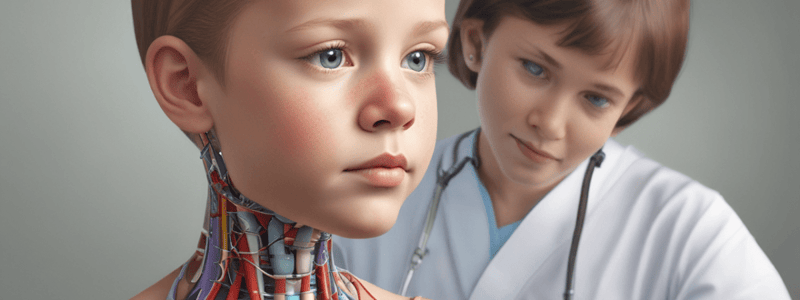Podcast
Questions and Answers
During the examination of the oral mucosa, what is inspected?
During the examination of the oral mucosa, what is inspected?
- Tonsils and oropharynx
- Soft and hard palate
- Orifices of parotid and submandibular glands (correct)
- All of the above
What is examined during the head and neck examination?
What is examined during the head and neck examination?
- Face, neck, ears, and mouth (correct)
- Only the face
- Only the face and neck
- Face, neck, and ears
How is the examination of the hands performed?
How is the examination of the hands performed?
- Only the fingers are examined
- Only the palms are examined
- A quick examination is done, and if an abnormality is detected, a more detailed examination is carried out (correct)
- A detailed examination is always carried out
What is inspected during the dental examination?
What is inspected during the dental examination?
What is examined during the neck examination?
What is examined during the neck examination?
What is inspected during the examination of the face?
What is inspected during the examination of the face?
What is the importance of uncovering in clinical examination?
What is the importance of uncovering in clinical examination?
What should you do during history taking in clinical examination?
What should you do during history taking in clinical examination?
What is essential for the examiner's hands before starting the clinical examination?
What is essential for the examiner's hands before starting the clinical examination?
What should be the examiner's approach to clinical examination?
What should be the examiner's approach to clinical examination?
Why is repetition important in clinical examination?
Why is repetition important in clinical examination?
When does the clinical examination start?
When does the clinical examination start?
What is the first step in conducting a patient examination?
What is the first step in conducting a patient examination?
What is included in the general inspection of the patient?
What is included in the general inspection of the patient?
Which of the following is NOT a component of the general examination?
Which of the following is NOT a component of the general examination?
What is the purpose of the Glasgow coma scale?
What is the purpose of the Glasgow coma scale?
What should the healthcare professional consider when examining the patient's hands?
What should the healthcare professional consider when examining the patient's hands?
Why is it essential to treat the patient as a whole, rather than focusing on a specific part of the body?
Why is it essential to treat the patient as a whole, rather than focusing on a specific part of the body?
What should you prioritize during clinical examination to confirm or rule out a suspected diagnosis?
What should you prioritize during clinical examination to confirm or rule out a suspected diagnosis?
During which part of the clinical examination can you make observations about the patient's memory, intelligence, and behavior?
During which part of the clinical examination can you make observations about the patient's memory, intelligence, and behavior?
What is essential for the examiner's hands before starting the clinical examination?
What is essential for the examiner's hands before starting the clinical examination?
What should you ensure during the clinical examination to prevent missing important findings?
What should you ensure during the clinical examination to prevent missing important findings?
When should you start making observations about the patient?
When should you start making observations about the patient?
What is examined during the examination of the ears?
What is examined during the examination of the ears?
What is inspected during the examination of the tongue?
What is inspected during the examination of the tongue?
What is examined during the examination of the face?
What is examined during the examination of the face?
What is inspected during the examination of the neck?
What is inspected during the examination of the neck?
What is the approach to examining the hands?
What is the approach to examining the hands?
What is the purpose of examining the shape and size of the hands?
What is the purpose of examining the shape and size of the hands?
What is the significance of Bean's lines in nail examination?
What is the significance of Bean's lines in nail examination?
What is the purpose of palpation in hand examination?
What is the purpose of palpation in hand examination?
What is koilonychia?
What is koilonychia?
What is the purpose of inspecting the oral mucosa?
What is the purpose of inspecting the oral mucosa?
During the general examination, what is assessed in addition to the level of consciousness?
During the general examination, what is assessed in addition to the level of consciousness?
What is inspected during the general inspection of the patient?
What is inspected during the general inspection of the patient?
What is the purpose of inspecting the attitude and position of the patient during the general examination?
What is the purpose of inspecting the attitude and position of the patient during the general examination?
What is included in the examination of the hands during the general examination?
What is included in the examination of the hands during the general examination?
Why is it essential to examine the patient's systems as a whole, rather than focusing on a specific part of the body?
Why is it essential to examine the patient's systems as a whole, rather than focusing on a specific part of the body?
Flashcards are hidden until you start studying
Study Notes
Preparation for Examination
- Ensure privacy and comfort for the patient
- Adjust room temperature and ensure your hands are warm
- Position the patient comfortably on the examination couch or bed
- Prepare necessary tools for examination
- Maintain hand hygiene and wash hands before examination
- Expose only the area to be examined
General Principles of Examination
- Follow standard textbook routine for clinical examination
- Practice clinical examination on multiple cases to improve skills
- Use history taking to form an idea about differential diagnosis or possible diagnosis
- Confirm or rule out suspected diagnosis during examination
Methodology of Examination
- Greet the patient and introduce yourself
- Explain the examination process and obtain verbal consent
- Follow principles of examination: inspection, palpation, percussion, auscultation, and special tests
- Perform a general examination of the whole body, not just the affected system
- Examine the affected system or regions of the body (CVS, RS, nervous system, abdomen, skin, musculoskeletal systems)
General Inspection of the Patient
- Assess level of consciousness and mental status
- Observe general facial appearance, expression, and abnormal movements
- Note any unusual odors, sounds, and attitude or skeletal deformities
- Check skin color, built, body fat distribution, and state of nutrition
- Assess hydration level
Head and Neck Examination
- Examine the head shape, size, and features (fontanelle and sutures in babies)
- Inspect ears, eyes, nose, mouth, lips, tongue, and teeth
- Check for cyanosis, ulcers, angular stomatitis, and pigmentation
- Examine the oral mucosa, tonsils, and oropharynx
- Inspect the face for deformities, pallor, and pigmentation
Hand Examination
- Perform a quick examination of the hands, and if abnormal, conduct a more detailed examination
Studying That Suits You
Use AI to generate personalized quizzes and flashcards to suit your learning preferences.




